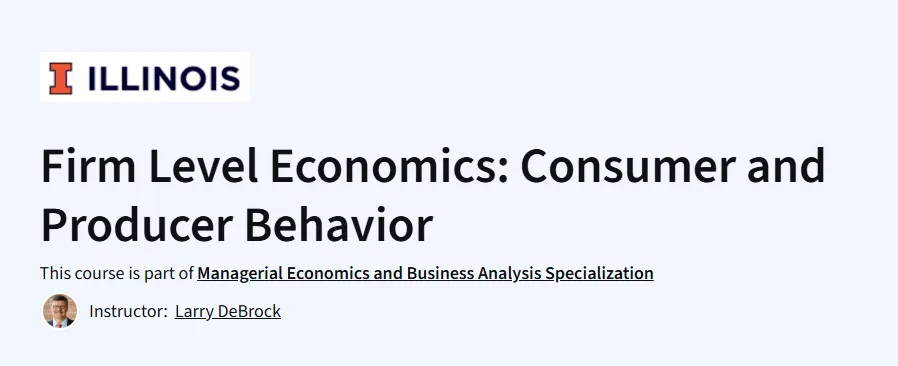What will you learn in Firm Level Economics: Consumer and Producer Behavior Course
Understand how firms make economic decisions under varying market conditions.
Analyze how firms allocate resources efficiently.
Explore the relationship between market structures and pricing strategies.
Apply economic models to real business scenarios.
Program Overview
Module 1: Introduction to Firms and Markets
⏳ 1 week
Topics: Firm behavior, supply & demand basics, market equilibrium
Hands-on: Identify how firms interact in different market settings
Module 2: Cost Structures & Production
⏳ 1 week
Topics: Short-run vs. long-run costs, economies of scale
Hands-on: Evaluate cost decisions in production planning
Module 3: Market Structures
⏳ 1 week
Topics: Perfect competition, monopolies, oligopolies
Hands-on: Compare pricing and output in various structures
Module 4: Firm Strategy in Competitive Markets
⏳ 1 week
Topics: Strategic decision-making, pricing models, barriers to entry
Hands-on: Analyze competitive dynamics using economic tools
Module 5: Allocation of Resources
⏳ 1 week
Topics: Efficiency, marginal analysis, welfare outcomes
Hands-on: Assess real-world case studies of resource allocation
Get certificate
Job Outlook
Strong foundation for careers in consulting, economics, data analysis, and strategic planning.
Useful for MBA students and professionals in finance, business, or public policy.
Salaries range from $60K to $150K+ for roles that value microeconomic analysis and decision modeling.
Builds analytical skills required for roles in market research, corporate strategy, and business analysis.
Specification: Firm Level Economics: Consumer and Producer Behavior
|
FAQs
- Basic economics knowledge is helpful but not mandatory.
- Introduces firm behavior, supply and demand, and market equilibrium.
- Focuses on practical applications for business decisions.
- Accessible to students, professionals, and MBA aspirants.
- Uses clear examples to explain theory.
- Explains short-run vs. long-run costs and production decisions.
- Covers pricing strategies for perfect competition, monopolies, and oligopolies.
- Teaches strategic decision-making using economic models.
- Includes real-world case analysis for practical understanding.
- Helps predict firm behavior in different markets.
- Prepares for roles like Business Analyst, Strategy Consultant, or Market Analyst.
- Strengthens analytical thinking and economic modeling skills.
- Relevant for finance, corporate strategy, and public policy professionals.
- Average salaries: $60K–$150K+ for roles leveraging microeconomic analysis.
- Provides a foundation for MBA programs or further economics studies.
- Hands-on activities include market structure comparisons.
- Evaluates cost decisions in production planning.
- Uses real-world examples for resource allocation analysis.
- Reinforces theoretical concepts through application.
- Builds skills for data-driven business decision-making.
- 5 modules, ~1 week each.
- Covers firm behavior, cost structures, market structures, strategy, and resource allocation.
- Self-paced learning with lifetime access.
- Certificate awarded upon completion.
- Total time: ~5 weeks at a moderate pace.





